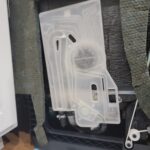Have you ever found yourself ready to tackle your lawn, only to discover that your trusty Troy Bilt Bronco just won’t start? Frustrating, isn’t it?
You’re not alone. This common issue leaves many homeowners scratching their heads, wondering what went wrong and how to fix it. Don’t let this hiccup ruin your plans. Imagine the satisfaction of knowing exactly how to diagnose and resolve the problem, getting your mower back up and running smoothly.
This article will guide you through simple, actionable steps to troubleshoot your Troy Bilt Bronco, saving you time and stress. With the right insights, you’ll be back to maintaining your lawn like a pro. Ready to dive in and solve the mystery? Let’s get your mower roaring back to life!

Credit: www.reddit.com
Common Causes
Your Troy Bilt Bronco won’t start? You’re not alone. This issue can be frustrating, especially when you need your mower for a quick job. However, understanding the common causes can save you time and effort. Let’s dive into what might be keeping your mower from roaring to life. You’ll be surprised how a little troubleshooting can make a huge difference.
Fuel Issues
Fuel problems are a frequent culprit. Is there enough gas in the tank? You’d be surprised how often empty tanks are overlooked. If the fuel is old, it might not ignite properly. Consider freshening it up. Also, check if the fuel line is clogged. A simple inspection can prevent unnecessary headaches.
Battery Problems
The battery is another common issue. Imagine going through all the checks only to realize the battery is dead. Check the connections to ensure they’re secure. Corrosion can be sneaky; clean those terminals to maintain a solid connection. If your battery is old, it might be time for a replacement. A little vigilance here saves plenty of time.
Spark Plug Concerns
Spark plugs are tiny but mighty. If your spark plug is dirty or worn out, it won’t ignite the fuel properly. This can lead to a silent mower. Check the plug for dirt or damage. A quick clean or replacement might be all it takes. How often do you inspect your spark plugs? A regular check can avoid surprises.
Could understanding these common causes prevent your next mower meltdown? Take action today to ensure your Troy Bilt Bronco starts when you need it. It’s not just about fixing problems; it’s about maintaining peace of mind.

Credit: www.youtube.com
Fuel System Checks
Experiencing issues with a Troy Bilt Bronco not starting often points to fuel system checks. Inspect fuel lines for blockages or leaks. Ensure the fuel filter is clean and the tank has fresh fuel. Regular maintenance prevents starting problems and keeps your lawn mower running smoothly.
When your Troy Bilt Bronco won’t start, the fuel system often holds the key to resolving the issue. You might think of the fuel system as the heart of your lawnmower, pumping life into the engine. Ensuring that every component within this system operates smoothly is crucial for a seamless start. Let’s dive into some essential checks and maintenance tasks that can help get your Bronco back on track.Inspecting Fuel Lines
First, give your fuel lines a thorough inspection. Check for any visible cracks or leaks. Even a small tear can prevent your mower from starting. Touch the lines to feel for any brittleness. Over time, fuel lines can harden and may need replacing. If you notice any damage, it’s time to swap them out. Have you checked the connections? Ensure all fuel line connections are tight and secure. Loose connections can lead to air entering the system, causing start-up issues.Cleaning The Carburetor
A dirty carburetor can often be the culprit behind a non-starting Bronco. Disassemble the carburetor carefully and clean it thoroughly. Use a carburetor cleaner spray to remove any build-up or debris. This ensures smooth fuel flow into the engine. Are you reassembling it correctly? Ensure each component fits back into its place snugly. An improperly assembled carburetor can lead to more problems.Replacing The Fuel Filter
Consider how long it’s been since you replaced the fuel filter. A clogged filter can restrict fuel flow, hindering the engine’s ability to start. Replacing the filter is a straightforward task. Simply remove the old one and fit in a new filter. It’s a small change that can make a big difference. After changing the filter, does the mower start more easily? A fresh filter often leads to improved engine performance, making your mowing tasks much smoother. By addressing these areas, you can potentially solve the starting problem. Have you found similar issues before with your mower, or did these tips help resolve your current predicament? Sometimes, it’s the small details that make all the difference.Battery And Electrical System
Trouble starting your Troy Bilt Bronco? The battery or electrical system might be the issue. Check for loose connections or a drained battery to get your lawn mower running smoothly again.
When your Troy Bilt Bronco decides not to start, the battery and electrical system might be the culprits. These components are crucial for powering your lawnmower and ensuring it runs smoothly. Understanding how to diagnose issues here can save you time and frustration.Testing The Battery
Start by checking the battery’s charge. A multimeter can be a handy tool for this task. Connect the multimeter to the battery terminals. A healthy battery should read around 12.6 volts. If the reading is lower, the battery may need charging or replacement. Have you ever left your mower unused for months, only to find the battery dead? Regularly testing the battery can prevent such surprises.Examining Electrical Connections
Loose or corroded connections can halt your Bronco in its tracks. Inspect the battery terminals for corrosion. Clean them with a wire brush if necessary. Ensure all connections are tight. It’s not uncommon for vibrations from mowing to loosen connections over time. Did you know that a small amount of dielectric grease can prevent corrosion and enhance conductivity?Alternator Functionality
The alternator charges the battery while your mower is running. If your battery keeps dying, the alternator might be faulty. Use a multimeter to check the voltage across the battery with the engine running. A reading between 13 to 14.5 volts indicates a working alternator. If the voltage is below this, the alternator might need attention. Are you familiar with the sound of a struggling engine? A failing alternator often gives subtle signs before a complete breakdown. Taking a proactive approach with your mower’s battery and electrical system can keep your lawn care routine smooth and hassle-free. Have you checked your battery and connections lately? It might be time for a quick inspection to ensure your Bronco is ready when you are.Spark Plug Examination
Troubleshooting a Troy Bilt Bronco that won’t start involves several steps. Examining the spark plug is a key step in this process. The spark plug ignites the fuel-air mixture in the engine. If it is faulty, the engine may not start.
Removing The Spark Plug
First, locate the spark plug on the engine. You will need a spark plug socket and a ratchet. Carefully remove the spark plug wire. Attach the socket to the plug and turn counterclockwise. Gently lift it out once loosened. Take care not to damage the surrounding area.
Cleaning Or Replacing The Spark Plug
Inspect the spark plug for damage or wear. If it’s dirty, clean it with a wire brush. Ensure the electrode gap is correct. If the plug is worn or damaged, replace it. A new spark plug can improve engine performance.
Testing Ignition Coil
After dealing with the spark plug, test the ignition coil. Reattach the plug to the wire and hold it against metal. Have someone start the engine. Look for a strong blue spark. A weak or absent spark indicates coil problems. Consider replacing the ignition coil if necessary.
Starter Motor And Solenoid
The starter motor and solenoid play crucial roles in starting your Troy Bilt Bronco. These components ensure your engine gets the power it needs to start. If your mower won’t start, these parts might be the culprits. Understanding their functions can help you troubleshoot effectively.
Inspecting The Starter Motor
The starter motor kicks the engine into motion. Check it for any visible damage. Look for loose wires or corrosion. Ensure all connections are tight and clean. Listen for any unusual noises. A clicking sound might indicate a faulty motor. If the motor is silent, it could be dead.
Checking The Solenoid
The solenoid acts as a bridge for electrical current. It helps power flow to the starter motor. Inspect the solenoid for any signs of wear. A faulty solenoid might cause starting problems. Ensure all wires are securely connected. Test the solenoid using a multimeter. A reading outside the normal range means it might need replacing.
Starter Relay Issues
The starter relay sends power from the battery to the starter motor. Check the relay for signs of damage. Listen for a clicking sound when you turn the key. No sound could mean a faulty relay. Ensure it’s properly seated in its socket. Replace it if necessary to restore starting function.
Engine Compression
Engine compression issues might cause a Troy Bilt Bronco to not start. Low compression can prevent the engine from generating enough power. Regular maintenance checks can help identify and fix this problem early.
The issue of your Troy Bilt Bronco not starting can be frustrating. A common culprit can be engine compression. Engine compression is vital for the engine to start and run efficiently. Without the right compression, your engine may struggle to fire up or run smoothly.Performing A Compression Test
A compression test is a straightforward way to check your engine’s health. You’ll need a compression tester, which you can find at most auto parts stores. Ensure your engine is off and cooled down before starting. Remove the spark plug and insert the tester into the plug hole. Turn the ignition as if starting the engine. The gauge will display the compression level. Record these numbers for each cylinder.Interpreting Results
After testing, you’ll need to interpret the results. A healthy engine typically shows compression readings within a specific range, often around 90-150 psi. A significant variation between cylinders can indicate a problem. Consistently low readings may mean worn piston rings or a blown head gasket. If one cylinder is significantly lower than others, it could be a valve issue. These insights help you pinpoint where to focus your repairs.Addressing Low Compression
Low compression isn’t the end of your mower’s life. Start by checking for simple solutions like a loose spark plug or a clogged air filter. Tightening or replacing these can sometimes solve the problem. If the issue persists, you may need to inspect the pistons and valves. This could require professional help if you’re not comfortable with engine internals. Regular maintenance can prevent many compression-related issues, ensuring your mower starts smoothly every time. Have you ever faced a similar issue with your mower or another engine? How did you tackle it? Share your thoughts and experiences in the comments below.Safety Switches And Sensors
Safety switches and sensors play a crucial role in your Troy Bilt Bronco mower. They ensure safe operation by preventing the engine from starting under unsafe conditions. These components are vital for protecting both the user and the machine. Problems with safety switches or sensors may lead to your mower not starting. Understanding their location and functionality is essential for troubleshooting.
Locating Safety Switches
Safety switches are typically found near the seat, brake pedal, and mower deck. The seat switch prevents the mower from running if no one is seated. The brake pedal switch ensures the brake is engaged before starting. The mower deck switch stops the blades from turning when starting the engine. Knowing their exact location helps in quick diagnosis.
Testing Sensor Functionality
Testing sensors involves checking for any visible damage or loose connections. Use a multimeter to test the continuity of each switch. A functioning switch will show a completed circuit when engaged. If any switch fails this test, it might be faulty. Regular testing can prevent unexpected issues during mowing.
Bypassing Malfunctioning Switches
Bypassing a faulty switch is a temporary solution. It’s essential to address the root cause later. To bypass, locate the switch’s wiring. Disconnect and join the wires to close the circuit. This may allow the mower to start. Remember, bypassing compromises safety. Always replace faulty switches promptly.

Credit: www.reddit.com
Routine Maintenance Tips
Troubleshooting a Troy Bilt Bronco that won’t start involves checking the battery, spark plug, and fuel levels. Inspecting these components regularly can prevent common starting issues. Regular maintenance ensures your mower remains reliable and efficient.
Maintaining your Troy Bilt Bronco properly can save you time, money, and frustration. You might think your mower is giving up, but often, it’s just asking for a little TLC. By sticking to a routine maintenance schedule, you can keep your mower running smoothly and extend its lifespan. Here are some practical tips to get you started:Regular Oil Changes
Oil is the lifeblood of your mower’s engine. Fresh oil keeps the engine parts well-lubricated and prevents overheating. Change the oil after every 50 hours of use or at the start of each mowing season. Check the oil level before each use. Low oil can lead to engine damage, while too much oil can cause leaks. It’s a simple task that takes minutes but can prevent hours of repair.Seasonal Tune-ups
Every season brings its own set of challenges for your mower. A seasonal tune-up can ensure that your mower is ready to tackle them. Replace the spark plug and air filter to keep the engine firing efficiently. Sharpen the blades to avoid ripping grass instead of cutting it cleanly. Have you ever noticed your lawn looking ragged after mowing? Sharp blades make a huge difference.Storing The Mower Properly
Proper storage is crucial, especially during the off-season. Clean the mower thoroughly to remove grass clippings and dirt. This prevents rust and keeps the mower in good condition. Store it in a dry place to avoid moisture damage. If space is an issue, consider using a protective cover. Have you ever found your mower with rust spots after winter? A little protection goes a long way in preserving your equipment. Routine maintenance might seem tedious, but neglecting it can lead to bigger problems down the line. Are you ready to invest a bit of time now to save yourself from costly repairs later?Frequently Asked Questions
Why Won’t My Troy Bilt Bronco Start?
Check the fuel level. Ensure the battery is charged. Inspect spark plug for damage.
How Can I Troubleshoot Starting Issues?
Verify fuel is fresh. Clean the air filter. Examine the ignition switch.
What Should I Do If The Engine Cranks But Won’t Start?
Inspect the fuel line. Check for clogged filters. Ensure the choke is functioning.
Could A Dead Battery Cause Starting Problems?
Yes, a dead battery can prevent starting. Recharge or replace it if needed.
How Do I Know If The Spark Plug Is Faulty?
Remove and inspect the spark plug. Look for wear or carbon buildup. Replace if necessary.
Conclusion
Troubleshooting a Troy Bilt Bronco can be straightforward. Start with basic checks. Examine the battery connections. Ensure the fuel tank isn’t empty. Look for clogged air filters. Inspect spark plugs for damage. Regular maintenance prevents future problems. Clean parts and check wiring regularly.
Follow the user manual for guidance. Professional help might be needed sometimes. Take action early to avoid costly repairs. A well-maintained mower means a smooth start every time. Keep learning, keep your mower running. Your lawn deserves the best care possible.
Happy mowing!





